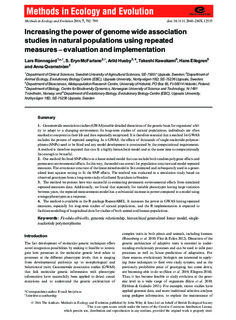| dc.contributor.author | Rönnegård, Lars | |
| dc.contributor.author | McFarlane, S. Eryn | |
| dc.contributor.author | Husby, Arild | |
| dc.contributor.author | Kawakami, Takeshi | |
| dc.contributor.author | Ellegren, Hans | |
| dc.contributor.author | Qvarnström, Anna | |
| dc.contributor.author | Freckleton, Robert | |
| dc.date.accessioned | 2017-10-30T08:54:46Z | |
| dc.date.available | 2017-10-30T08:54:46Z | |
| dc.date.created | 2015-12-16T13:39:47Z | |
| dc.date.issued | 2016 | |
| dc.identifier.issn | 2041-210X | |
| dc.identifier.uri | http://hdl.handle.net/11250/2462727 | |
| dc.description.abstract | 1. Genomewide association studies (GWAS) enable detailed dissections of the genetic basis for organisms’ ability to adapt to a changing environment. In long-term studies of natural populations, individuals are often marked at one point in their life and then repeatedly recaptured. It is therefore essential that a method for GWAS includes the process of repeated sampling. In a GWAS, the effects of thousands of single-nucleotide polymorphisms (SNPs) need to be fitted and any model development is constrained by the computational requirements. A method is therefore required that can fit a highly hierarchical model and at the same time is computationally fast enough to be useful.
2. Our method fits fixed SNP effects in a linear mixed model that can include both random polygenic effects and permanent environmental effects. In this way, the model can correct for population structure and model repeated measures. The covariance structure of the linear mixed model is first estimated and subsequently used in a generalized least squares setting to fit the SNP effects. The method was evaluated in a simulation study based on observed genotypes from a long-term study of collared flycatchers in Sweden.
3. The method we present here was successful in estimating permanent environmental effects from simulated repeated measures data. Additionally, we found that especially for variable phenotypes having large variation between years, the repeated measurements model has a substantial increase in power compared to a model using average phenotypes as a response.
4. The method is available in the R package RepeatABEL. It increases the power in GWAS having repeated measures, especially for long-term studies of natural populations, and the R implementation is expected to facilitate modelling of longitudinal data for studies of both animal and human populations. | nb_NO |
| dc.language.iso | eng | nb_NO |
| dc.publisher | Wiley | nb_NO |
| dc.rights | Navngivelse 4.0 Internasjonal | * |
| dc.rights.uri | http://creativecommons.org/licenses/by/4.0/deed.no | * |
| dc.title | Increasing the power of genome wide association studies in natural populations using repeated measures - evaluation and implementation | nb_NO |
| dc.type | Journal article | nb_NO |
| dc.type | Peer reviewed | nb_NO |
| dc.description.version | publishedVersion | nb_NO |
| dc.source.journal | Methods in Ecology and Evolution | nb_NO |
| dc.identifier.doi | 10.1111/2041-210X.12535 | |
| dc.identifier.cristin | 1301667 | |
| dc.relation.project | Norges forskningsråd: 223257 | nb_NO |
| dc.relation.project | Norges forskningsråd: 214553 | nb_NO |
| dc.description.localcode | © 2016 The Authors. Methods in Ecology and Evolution published by John Wiley & Sons Ltd on behalf of British Ecological Society. This is an open access article under the terms of the Creative Commons Attribution License. | nb_NO |
| cristin.unitcode | 194,66,10,0 | |
| cristin.unitname | Institutt for biologi | |
| cristin.ispublished | true | |
| cristin.fulltext | preprint | |
| cristin.qualitycode | 2 | |

